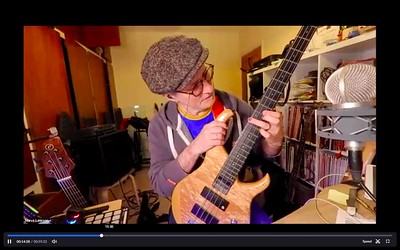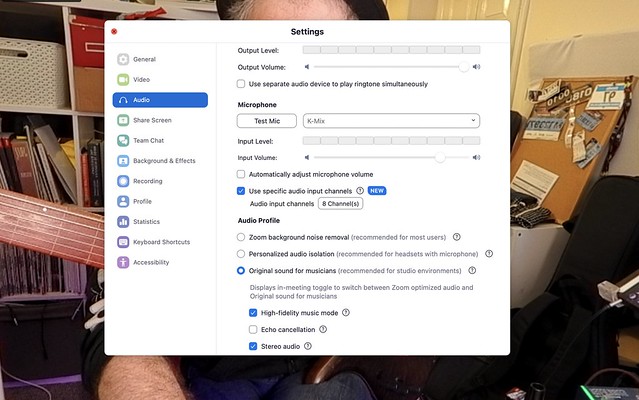 Weird thing I just remembered. I once did a voice-over job for Microsoft – about 20 years ago. I can’t remember what the product was, but I remember that the opening line of the script was “Why do we teach? To change the world one student at a time”, and despite that being cheesy MS marketing copy, it still holds true.
Weird thing I just remembered. I once did a voice-over job for Microsoft – about 20 years ago. I can’t remember what the product was, but I remember that the opening line of the script was “Why do we teach? To change the world one student at a time”, and despite that being cheesy MS marketing copy, it still holds true.
It’d be hard to argue that there’s ever been a better time to learn an instrument. Just as with music and TV and art and games, the world is awash with extraordinary educational materials with a degree of accessibility that was utterly inconceivable when I was at college in the early 90s. Back when poorly presented instructional VHS tapes cost as much as a week’s rent and books came with a flexi-disc of examples.
Several times a month I get asked why I don’t have an online course available, why when I’ve taught online for over 15 years I still haven’t done my own downloadable offering. In these days of every creative trying to figure out ‘how to get paid while you sleep’ it’s the obvious thing to do.
But the reason is simple – I’m a REALLY good one on one music teacher, and that offers something that no course or video lesson can give: instant feedback. I mean, I DO teach online, on Zoom, all of my bass teaching is remote – which means I can teach students from all over the world (still no students from Antarctica, but have taught people from every other continent 😉 ). I also do a monthly live session for Musical-U that offers an amazing space to consider how to maximise the value of a group session like that for the attendees. And my private students all get a video of every lesson to download, so they can rewatch it as many times as they want.
Private music lessons are about more than information. They’re a form of mentorship, a way to help guide not only someone’s technical development but their journey into music making. And in that setting, it can be far more precisely student-led. Instead of the self-study path through pre-recorded material being one of foraging through everyone’s free taster lessons on YouTube, it becomes about the teacher’s expertise and experience being applied to guiding the student through the knowledge, technical and listening skills and psychology of playing their preferred style of music in their preferred setting.
The standardisation of material and method in music teaching is a trend that favours teachers not students. If you can write one course and sell it to everyone, that’s an efficient business model, right? Yup, but it’s not ideal for the student whose interests only partially intersect with the assumptions at the heart of the pre-recorded material.
This is not at all an anti-online course essay – I have recorded multiple courses for ScottsBassLessons and use a lot of other people’s pre-recorded tuitional material in my own learning, just as I absolutely rinsed Alexis Sklarevski’s “The Slap Bass Program” in the early 90s.
But falling in line with an economic trend would undermine that which I do best, which is helping to guide the learning journey of curious music makers across the spectrum of styles and intentions. From gigging/recording solo artists to people content to play along with their favourite records and develop a deeper understanding of what’s going on in that music that has soundtracked their entire lives. There’s no imposed hierarchy of assumed creative paths. Everyone’s creative desires are met with respect and a unique combination of learning materials to guide them. And in a lot of cases, those lessons are complimenting additional learning elsewhere. As it should be.
If that sounds interesting to you, drop me a line and we can see if there’s space in our schedules to make lessons happen. See my teaching page for all the details.



 Heading into the COVID lockdown and everything moved online. I wrote tutorials for other teachers and performers in how to set up for streaming lessons and gigs, and got on with moving all my bass teaching online.
Heading into the COVID lockdown and everything moved online. I wrote tutorials for other teachers and performers in how to set up for streaming lessons and gigs, and got on with moving all my bass teaching online. I am adamant that it is not my job to decide the exact path every student should go on. My students are almost exclusively grown-ass adults with a lifetime’s experience as music listeners, and generally some familiarity with the instrument (I love teaching total beginners, but it doesn’t happen very often). My task is to equip them to play the music that inspires and motivates them, to plot a journey towards their own creative aspirations and intentions. For some of them that’s playing bass in a band in a particular genre. For others it’s about broadening their general skill set regarding navigating the fretboard in terms of keys and melodic/intervallic patterns. For some it’s developing a practice towards building a vocabulary for improvisation, and still others it’s playing solo. I don’t decide what they should want to do, I just give them the tools to get there. And in any given week, I give them WAY more tools than they need, because I can, and because while rewatching the video there might be one section that really connects with them that they can watch over and over again and really dig into. They also have a document of their own playing that can be really useful for reflective and reflexive assessment of where they are up to.
I am adamant that it is not my job to decide the exact path every student should go on. My students are almost exclusively grown-ass adults with a lifetime’s experience as music listeners, and generally some familiarity with the instrument (I love teaching total beginners, but it doesn’t happen very often). My task is to equip them to play the music that inspires and motivates them, to plot a journey towards their own creative aspirations and intentions. For some of them that’s playing bass in a band in a particular genre. For others it’s about broadening their general skill set regarding navigating the fretboard in terms of keys and melodic/intervallic patterns. For some it’s developing a practice towards building a vocabulary for improvisation, and still others it’s playing solo. I don’t decide what they should want to do, I just give them the tools to get there. And in any given week, I give them WAY more tools than they need, because I can, and because while rewatching the video there might be one section that really connects with them that they can watch over and over again and really dig into. They also have a document of their own playing that can be really useful for reflective and reflexive assessment of where they are up to.


